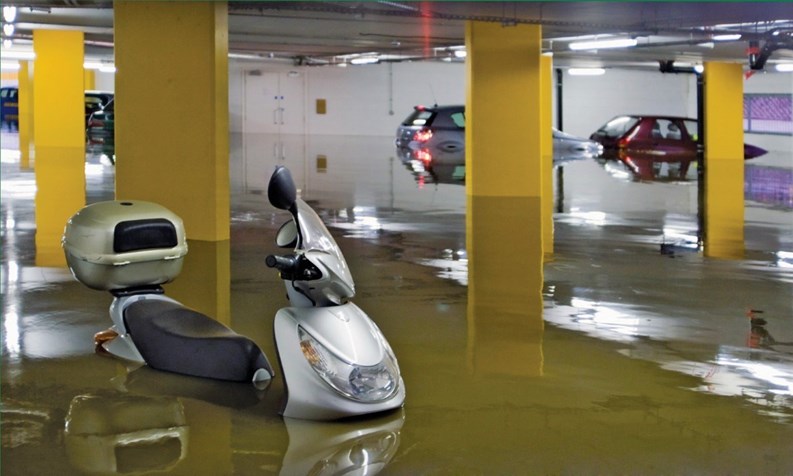Edgar Dworsky is the treasurer of a small Somerville, Massachusetts condo complex that was built back in 1987. He loves where he lives except for one, quite large, problem. Water leaks have plagued the complex since it was built. During driving rains, water comes in from around the windows and near the chimney. The association has tried numerous solutions to fix the problem, but nothing has worked very well.
“Water problems are completely frustrating and expensive to try to fix,”says Dworsky.
Water leaks are one of the most damaging things that can happen to a condo, whether in the units or on the common property –especially if, like Dworsky’s complex, they are stealthy leaks that are hard to detect. Among other things, the leaks can be caused from a poorly-constructed building, old pipes, poorly-maintained valves, and damage caused by other factors such as storms.
“Everybody that we’ve had in here has told us where they think it’s coming from, and every person has been different, but nobody has been right,” says Dworsky.
While trying to find the problem, the unit owners have replaced the weather stripping around their windows, and management has caulked the chimney, added storm collars and waterproofed the chimney’s exterior. They have gone as far as replacing the roof, all to no avail –water is still coming in.
Although Dworsky’s building problems seems to have started at the construction phase, Russell Fernandes, principal and vice president of Becht Engineering, BT, Inc., says that roofs and siding or façade leaks can develop at any time in a building’s life span.
“Pipes begin to deteriorate in the 20 to 30 year range of a building’s life,” says Fernandes. “This is particularly troublesome in high-rise buildings with large riser pipes – pipes which run from basement to top floor, inside walls – to supply everything from hot and cold domestic water to air conditioningand heating.”
Water, Water, Wherefore Art Thou?
Fernandes explains that there are three main causes for water leaks in buildings – a water leak in the buildingenvelope, which is the roof, walls and windows; a foundation leak from ground water; or a leak from a plumbing system, whether it’s fresh water or sanitary sewer drain lines.
Water leaking around a window is usually coming from the flashing and/ or intersection with the exterior sidingsystem. Flashing is the thin layer of waterproof material that keeps water from getting into the building.
“Downspouts that are not functioning properly can result in foundation leaks into basements and crawl spaces,” he says. “Roof water should be directedas far away from the foundation as possible. Downspouts should either discharge on splash blocks to direct roof water away from a building’s foundation or even better, into an underground drainage system connected to the storm water system.”
Leaks will give out signs that they are there. The most obvious sign is that you’ll see water, but if water isn’t visible you may see a stain on a wall or ceiling.
“For example, a roof leak can result from damage to the roof from a storm – perhaps the shingles blew off – or canbe the result of improper flashing,” says Fernandes.
“While such a leak can immediately be visible in the attic, it can sometimestake a little time to show up in the living space. Often the first sign of a roof leak is an unexplained stain in the ceiling.”
Odor Issues
If it’s a wastewater problem, Robert J. Burns, P.E., R.S. of Burns Associates-Engineers in Portsmouth, New Hamp-shire, explains that you’ll have an odor issue. If the leak is on the property, he also says you may have an unexplainedwet spot in your landscaping.
“You may also have a noticeable drop in water pressure or there may be rusty water where dirt is getting into the leak,” says Burns, who also says that other non-water signs include cracking in the pavement, sink holes and pot holes.
If a leak has been occurring for quite some time, your first sign may, unfortunately, be mold. “One condo that was renovated had a leak that came from a screw that hit a water line,” says Jeffrey C. May, founder andprincipal scientist of May Indoor Air Investigations, LLC in Tyngsborough, Massachusetts. “It leaked for months and the mold grew.”
If you’re not sure if there’s a leak on the premises, you can use a water meter to determine if you have a leak. Turn off all the water to the property, both inside and outside. If the flow indicator on the water meter is still moving after all the water is turned off, there’s a leak somewhere.
Leaks don’t have to be a surprise. Keep an eye on your water bill, too. If there is a spike in water usage, trace it to see what might have happened. “One association was adding more and more water to their pool every day and the water usage went up drastically,” says Burns. “It was a liner problem with the pool, but it started with a paper chase.”
Finding the Source
So you see signs of water, staining ormold, but where exactly is it coming from? Well, it’s time to put on your Inspector Clouseau hat and do a little more detective work (without his bumbling and stumbling, of course). There are some technologies that can help you determine the problem, including infrared cameras, moisture meters and fiber optic video cameras. However, it’s best to leave the more elaborate equipment, such as the cameras, to the professionals.
Every object emits heat radiation, and a thermal imaging camera picks up that radiation. The sensor in the camera then converts the radiation into a thermal image so you can see if there is water. “An infrared camera allows the user to see into a wall and find wet insulation and other materials,” says Fernandes. “This is possible because wet building materials will have different thermal characteristics than those same materials when dry. For example, dry wall insulation in an exterior will return to fairly close to ambient temperature fairly quickly once the sun stops shiningon the wall. However, wet insulation will retain some of the heat longer, which will show up as a “hot” spot with an infrared camera.”
May says that infrared cameras can also determine a concealed drain pipe leak, though the presence of damp drywall must always be confirmed by the use of a moisture meter, “which measures the conductivity of the surface and the moisture content.”
Fiber Optic Cameras
Pipes in walls and underground surfaces can also be scanned with fiberoptic video cameras that can be fed into a piping system from one end, allowing a complete inspection of the pipes from the inside.
“You can send video down the line and see if you have a leaky joint or a crack in the pipe,” says Burns. “You can do grouting or fix the leak or just record the condition of the pipe.”
Sonic leak detection can also help. “You can put the phone on top of the ground and hear the water moving around,” says Burns. “You can pinpointthe leak but you have to be skilled in how to do it.”
Dworsky says that his association has been tempted to use the X-ray-like moisture detection technology, “but at roughly $1,500 for a limited examination, we felt it would not ultimately lead us to the source of the problem,” he says.
May disagrees and believes that testing needs to be done. “The most important thing is that you need to determine the source of the leak by testing,” says May. “You can’t replace a roof without testing to see where the water is coming from.”
No matter how big or small, every leak should be fixed or it can become more costly in the long run. “A small leak can even cost you more money and more water over time than a large leak, because it’s been going on for a while and water pressure is going down,” says Burns. “Also small leaks will almost always eventually become large leaks –and it is always more expensive to fix large leaks than small leaks.”
Repairing the leak depends on exactly what is causing it and where it is. “If you have a crack you can reline or recoat it, but it depends on how bad things are,” says Burns. “It’s a point-by-point decision to repair or replace.”
For underground piping, Fernandes explains that certain pipes can be repaired with a procedure that installs a lining inside the pipe which hardens and makes the existing pipe water-tight. “This can often be accomplished with little or no excavation required,” he says.
The bottom line: Associations need to be proactive and recognize signs of leaks, and repair them before they spiral out of control.
Lisa Iannucci is a freelance writer and a frequent contributor to New England Condominium magazine.







Leave a Comment